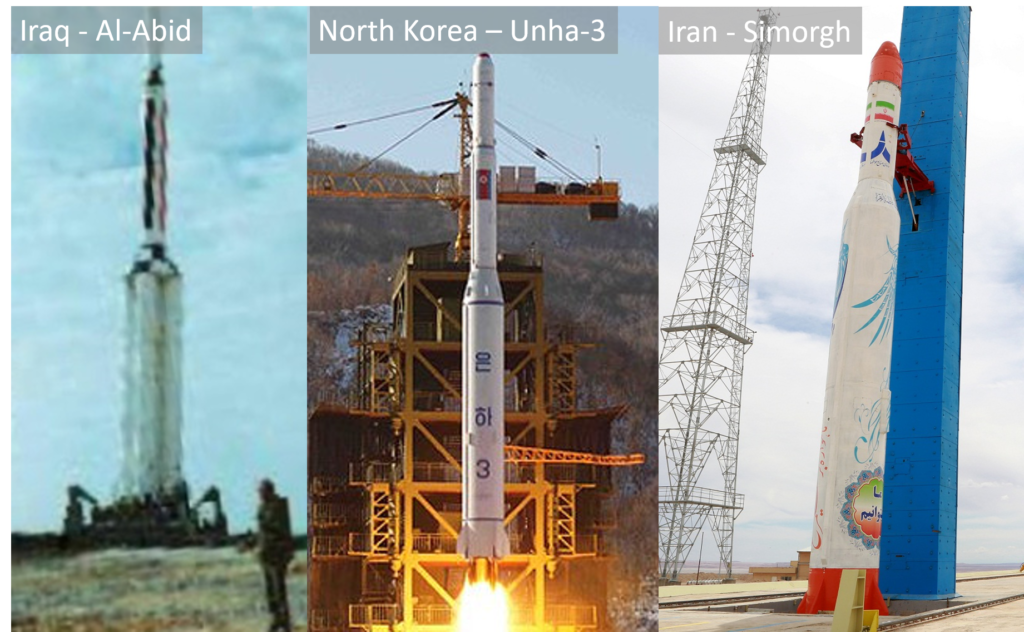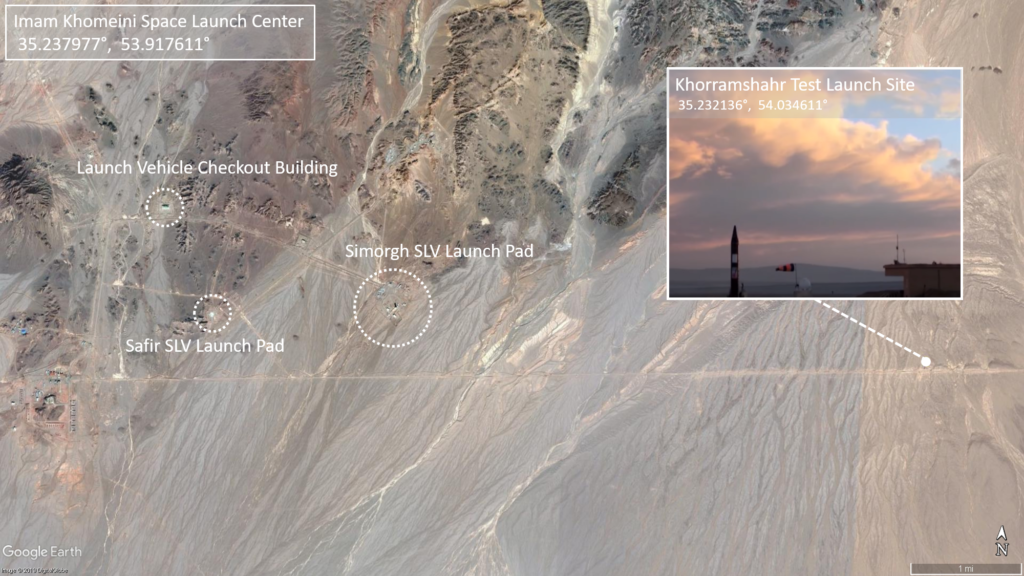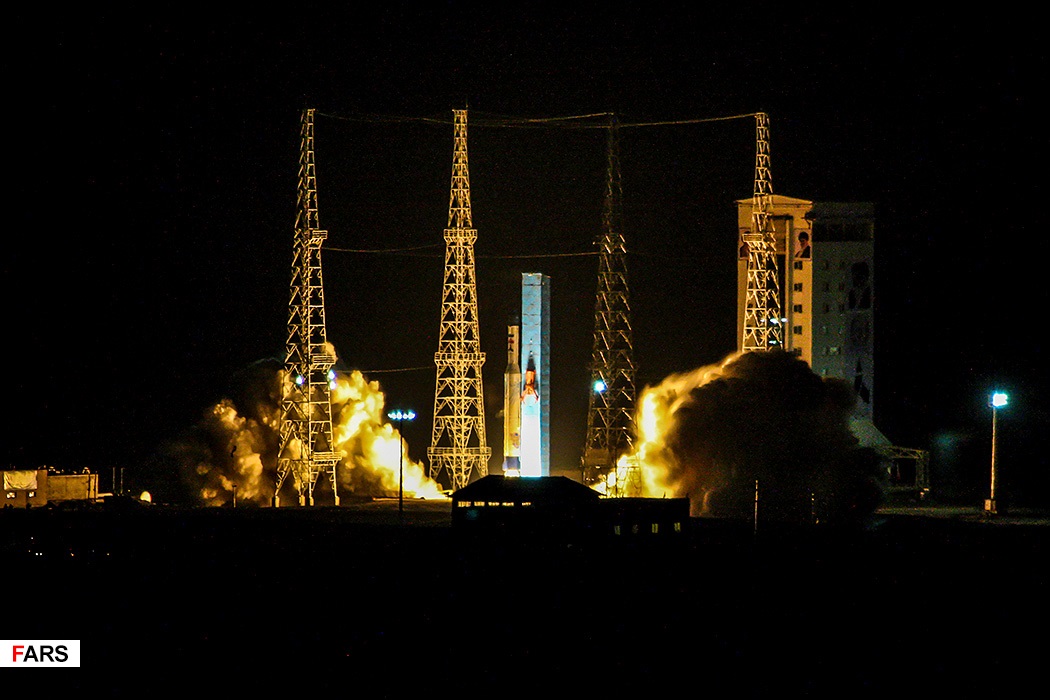A nation must think before it acts.
On January 3, Secretary of State Mike Pompeo announced that Iran was preparing to launch multiple Space Launch Vehicles (SLV), which he claimed had “virtually (the) same technology as ICBMs,” before issuing a threat, “We won’t stand by while the regime threatens international security.” Almost a week prior to that announcement, our team at the Center for Nonproliferation Studies was alerted to the same event by open-source researcher Fabian Hinz, who was seeing an uptick in prelaunch indicators leading up to the January 14 launch.
Starting in late December, we began monitoring the site with the help of San Francisco-based satellite imaging company Planet Labs. With daily images of the Imam Khomeini Space Launch Center (IKSLC), we were able to identify a variety of prelaunch signatures and activity at the launch vehicle checkout building, and at both launch pads prior to the launch of the Payam satellite aboard its Simorgh launcher. While the launch ultimately failed to insert the Payam satellite into orbit, questions as to the nature of this launch, the connection to Iran’s alleged secret desire to build an intercontinental range ballistic missile (ICBM) capable of striking targets in the United States, and a country’s ambition to utilize space for advancing domestic scientific capabilities needs to be discussed as to prevent this most recent launch from being misconstrued and used to support false assertions about the linkage between a space launcher and an ICBM, which could then influence policymaking.
What Happened?
The CNS team identified visible pre-launch activity on January 4, with the arrival of a large trailer, used at past launches, at the launch vehicle checkout facility. While the size of the Payam satellite, and recent trends in Iran’s space program, indicated the likely use of their “newer” Simorgh SLV, we also identified activity at Iran’s older circular pad, used for launching the smaller two-stage Safir (Ambassador) SLV.
The initial pre-launch signatures, followed by a string of video releases by Iranian media displaying the Payam satellite running through its final inspections prior to moving to the IKSLC, made this attempt much more transparent compared to previous ones. Just two days prior to the launch itself, we were able to catch two images, on the same day, of the large trailer associated with space launch activity, moving from the checkout location to the larger launch pad for prelaunch activity and inspections.

PLANET LABS INC.

PLANET LABS INC.
After the launch, Iranian Minister of Communications and Information Technology Mohammad Javad Azari Jahromi (who also runs an active Twitter / Instagram account) announced that the Payam satellite failed to reach the speed necessary for the Payam satellite to reach orbit. He even posted a ground video of the satellite separating on Twitter.
While Iran’s launch attempt failed, as noted by both Secretary Pompeo and Iranian officials, there will be another launch in the near future of the Dousti (Friendship) satellite. As it reportedly weighs around 52 kilograms, it is possible that the recent spike in activity seen at Iran’s older circular launch pad is a sign that they will be using their smaller launcher, the Safir, which was last used in 2015.
Virtually the Same Technology
Secretary Pompeo’s comment on Iran’s SLV having “virtually (the) same technology as ICBMs” is interesting because it is neither entirely true, nor entirely false. As is true for many countries around the world, Iran’s missile and rocket program is based on technology derived from the Soviet Scud-B, a missile system that North Korea sold all over the world, and which Iran acquired in the 1980s. It is from this same Scud system that countries like Iran, Iraq, Pakistan, and North Korea modified to extend the range of their early offensive missile program.

From these modified systems, Iraq and North Korea forged ahead by clustering their longest-range missiles and stacked them to create what was at the time a long-range missile program in disguise—or at least the start of one. Iraq’s Al Abid never really went anywhere, while North Korea’s Taepodong-1 and later the Taepodong-2 (also known as the Unha or Galaxy class SLV) would initially be replaced with missile systems like the KN-08. This untested system relied on technology derived from the Hwasong-10 medium-range ballistic missile (MRBM), which, in turn, failed repeatedly and would again be replaced with “newer” designs leading to the Hwasong-12/14/15 systems, which were tested in 2017.
Iran, in form, followed the previous two examples by building two SLVs, the Safir and the Simorgh, by using the same principles of stretching and stacking its longest-range MRBMs to create these space launchers. The difference with Iran can be found in the failure to transition to more effective ICBM designs. While North Korea’s Taepodong-2 could be used as a weapon system, it was cumbersome, required extensive basing and prelaunch support, and was not optimally designed to work as an ICBM. The North Koreans likely realized this as being a short-term solution and sought to replace their scud-based system by acquiring and developing more advanced missile technology.
This is not to say that Iran hasn’t pursued newer technology for its medium-range missile systems. Iran acquired North Korea’s Hwasong-10 MRBM, which it is now testing a variant of under the name Khorramshahr. Iran and the DPRK have also collaborated on other missile component development. In early 2016, the U.S. Department of Treasury sanctioned individuals from Iran’s primary liquid fuel missile producer, the Shahid Hemmat Industrial Group (SHIG), for collaborating with the North Koreans on the development of a new 80-ton rocket booster. That same year, North Korea released images of a missile engine test that it claimed produced 80 tons of thrust.
This engine would not be seen on the DPRK’s latest space launcher. Instead, it appears that the 80-ton booster was carried over to the DPRK’s current ICBM program, suggesting that elements of Iran’s missile industry have some experience with larger and more powerful engine designs that have not appeared in Iranian media. While Iran has built on its missile expertise, what does its testing record say?
Iran’s testing cycle appears to be focused on refining their current, medium- and shorter-range capabilities, according to an analysis and database created by two of my colleagues, Shea Cotton and Jessica Varnum. The database also suggests that Iran is also moving towards establishing a larger solid-fuel missile fleet and production capability. Further analysis by Jeffrey Lewis, Fabian Hinz, and myself from last year seemed to reinforce this shift in focus from the liquid fuel behemoths of years past to a different kind of missile program that is more regionally focused and of an entirely different fuel type all together.
This brings us back to the most recent space launch and the broader questions about whether the program serves peaceful purposes, or if it is designed to test technologies to integrate into missiles at a later point. The answer, as always, is “it is complicated and not all together straight forward.” The Khorramshahr, the next controversial Iranian missile development taking place, is a perfect example of this complication as it was launched from (or near) the space launch facility.[1]
As previously mentioned, the North Koreans once tried to expand their use of this system to build ICBMs, which ultimately became showroom models due to their inability to work out design problems. While the Khorramshahr is still a medium-range missile system, there exists the possibility that the Iranians could work out what the North Koreans couldn’t and create a new platform to extend and test as an ICBM design. However, the Iranians have yet to successfully test the Khorramshahr, and having elements that have worked on more powerful engines, it is less likely that they would sink the time into following the failed North Korean program instead of skipping on to something more similar to the Hwasong-12/14/15.


Legacy Issues in Missile Development
While Iran is continuing to develop and diversify its short- and medium-range ballistic missiles, it has for the most part not followed North Korea’s lead in developing missiles with a range drastically over the Supreme Leader’s self-imposed limit of 2,000 km.
It is important to think again about the assumption underpinning Secretary Pompeo’s warnings about Iranian interest in an ICBM. This assumption is linked to earlier interactions with North Korea. Government reports in the United States, Japan, and South Korea have frequently asserted that the Taepodong-2 (UNHA SLV) is still an ICBM with a 10,000 km+ range capable of striking the U.S. This assertion, however, belies the DPRK’s own-testing cycle and development of the Hwasong-14 and Hwasong-15, two intercontinental-range ballistic missiles that are unquestionably designed as deployable missile systems. While, at one point, these space launchers were likely intended as test platforms for ICBM components, the time has long passed for the North Koreans—and in a way the same stands for Iranian SLVs.
Having co-developed parts of the North Korean 80-ton booster, and continued testing of the Khorramshahr, has placed Iran in a position of being latently capable of further developing ICBMs without relying on the scud-based technology, which comprises its space launch program. To continue asserting its space launch activity is actually a secret ICBM program actually distracts from more pressing developments in Iranian missile technology that could potentially open a real pathway for an ICBM.

So is Iran Working on Developing an ICBM?
If Iran truly is developing ICBMs, then it isn’t building them off of the space launcher. As previously stated, the Iranian space launch fleet is built on much older technology, which is suboptimal for use as an ICBM. Presently, Iran has demonstrated access to the technology that would allow the country to follow in North Korea’s path to an ICBM, but this technological transfer hasn’t been fully observed in the Iranian space program either. We have not seen a Khorramshahr-based SLV, or an SLV with more powerful engines than the current cluster of old Shahab-3 engines on the Simorgh.
Iran’s current interest in further developing its solid fuel capabilities raises some concerns. Iran’s solid facilities near the city of Shahrud may be currently limited to refining its short-range solid-fueled missiles, including the Zolfaghar system that the Iranian Revolutionary Guards Corp used in at least two missile strikes against targets in northern Iraq and eastern Syria, but the site contains larger unused solid fuel test stands for designs that could have much longer ranges. The continued testing of the Khorramshahr is also concerning if you consider the older North Korean plan for extending it into an ICBM, but again, these designs are not reflected in Iran’s space launch program.
Iran’s missile program poses a serious challenge for U.S. policymakers, but its space ambition does little—at its current pace—to extend that threat. Iran’s most recent space launch was conducted with little secrecy, even admitting its ultimate failure. Iranian researchers have even announced plans to try again once it builds a replacement satellite. Withholding from blanket statements of condemnation and encouraging more transparency might go against the grain of past comments on Iran’s space launchers, but one might wonder if the U.S. has an incentive to do so. A focused space program has value as a way of clarifying capabilities and intentions, as it focuses Iranian efforts on technology that is not ideally suited for long-range military applications.
While we cannot be absolutely certain that Iran is not covertly developing or testing technology that would allow it to directly mirror North Korea’s rapid development of missiles capable of striking the U.S., its space launch program does not pose the threat that the administration is currently promoting. With known collaboration between Iran and the now-ICBM-possessing North Korea, there is fear that the Islamic Republic will quickly follow this path towards drastically advancing its missile range capability. This seems, however, not in its immediate interest or is reflected in the visible trajectory of its missile development trends. In short, these SLVs are not the ICBMs you are looking for.
[1] If you have access to TerraServer or a DigitalGlobe catalog, you can see prelaunch preparations at that site on 11/29/2019—possibly corresponding to the last State Department warning on the system.




